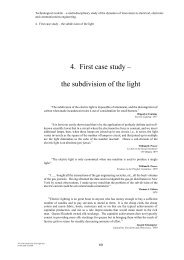Valuation Techniques for Social Cost-Benefit Analysis: - HM Treasury
Valuation Techniques for Social Cost-Benefit Analysis: - HM Treasury
Valuation Techniques for Social Cost-Benefit Analysis: - HM Treasury
You also want an ePaper? Increase the reach of your titles
YUMPU automatically turns print PDFs into web optimized ePapers that Google loves.
It is usually recommended that the specified institution, payment vehicle, and payment<br />
frequency should be those that would be most likely to be employed if the good were indeed<br />
supplied. For example, Tuan and Navrud (2007) estimate the value of a proposed preservation<br />
plan <strong>for</strong> a complex of religious temples in central Vietnam. They ask <strong>for</strong>eign visitors whether they<br />
would pay an increase in entrance fee <strong>for</strong> this plan, while they ask local residents whether they<br />
would bear an increase in local tax <strong>for</strong> it. Likewise, a one-time payment will be appropriate, <strong>for</strong><br />
example, in cases when the good is a one-time event (Carson, 2000). However, problems can<br />
arise if respondents refuse to answer or submit protest values as an objection to paying through<br />
some mechanism (e.g. council taxes). In such cases, adopting vaguer payment vehicle<br />
descriptions may be justified (see Bateman et al, 2002, p.131-133).<br />
Follow-up questions are useful <strong>for</strong> understanding the reasons behind respondents‘ valuations<br />
and <strong>for</strong> identifying respondents who are not responding with their true WTP in mind. For<br />
example (in an open ended contingent valuation <strong>for</strong>mat), some respondents may give a<br />
valuation of zero. This may be a protest response or it may represent their true WTP (see<br />
Bateman et al, 2002, p.145-147; or DTLR, 2002, p. 52-53).<br />
Questions on respondents‘ characteristics (e.g., age, income, education) are useful <strong>for</strong> assessing<br />
the representativeness of the sample and <strong>for</strong> providing variables to model the determinants of<br />
WTP. The later is done to test <strong>for</strong> theoretical consistency (i.e. does WTP increase with income) or<br />
to facilitate benefits transfer techniques (when valuation estimates from one study are applied to<br />
a different context (see Rosenberger and Loomis; 2003 <strong>for</strong> an introduction to benefit transfer<br />
techniques).<br />
A key design choice in contingent valuation questionnaires is how to present the valuation<br />
question(s). The most widely used elicitation <strong>for</strong>mats are: 1<br />
open ended;<br />
bidding game;<br />
payment card; and<br />
and dichotomous choice.<br />
The open-ended <strong>for</strong>mat is the most direct approach to valuation estimation. Respondents are<br />
simply asked their maximum WTP <strong>for</strong> the good under consideration. The question <strong>for</strong>mulation is<br />
along the lines of: ‗what is the maximum amount you would be prepared to pay (every period)<br />
through (payment vehicle) to receive the good just described?‘<br />
The bidding game <strong>for</strong>mat proceeds by asking respondents whether they would pay a given<br />
discrete amount <strong>for</strong> a good per period. If they respond ‗yes‘ (‗no‘), a series of higher (lower) bids<br />
are offered until they respond ‗no‘ (‗yes‘). An open-ended WTP question is then offered. The<br />
closed-ended bidding game <strong>for</strong>mat is a variant. This <strong>for</strong>mat does not finish with an open-ended<br />
WTP question.<br />
The payment card method presents respondents with a range of different listed monetary<br />
amounts. Respondent tick amounts they are willing to pay and put a cross next to amounts that<br />
they are not willing to pay.<br />
The dichotomous choice (or referendum method) gives respondents the chance to respond ‗yes‘<br />
or ‗no‘ to a single randomly drawn bid amount. There<strong>for</strong>e, the <strong>for</strong>mat offers respondents a<br />
binary choice between not having the good or having the good but giving up the offered price.<br />
The double-bounded dichotomous choice method is a variant. An additional higher (lower) offer<br />
is made if the respondent responds ‗yes‘ (‗no‘) to the first offer.<br />
1 Applied examples of each <strong>for</strong>mat, as well at the pros and cons of each, are given in tables 9.2 to 9.6 in DTLR (2002).<br />
57





![AIRTO [Professor Dr Brian Blunden] - HM Treasury](https://img.yumpu.com/15492848/1/184x260/airto-professor-dr-brian-blunden-hm-treasury.jpg?quality=85)










